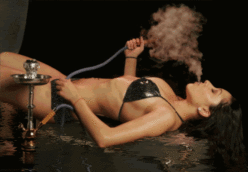The hookah has a long and storied history. Also known variously as a hubble-bubble, narghile, shisha, or water pipe, among other names, hookahs have been used for a mellow tobacco smoking experience in Asia and the Middle East for centuries. Coming to the Middle East from India, the hookah started out as a humble coconut shell. In Turkey, it evolved into the true hookah, becoming a mainstay of coffee house life during the 17th century. Hookah smoking is still very common in cafes and restaurants throughout the Middle East.
Many rituals, of preparation, lighting, and smoking etiquette, surround the use of the hookah. People gathered in the coffee houses to smoke together, exchanging news and stories–or simply sharing quiet, meditative time. Recalling a more relaxed and unhurried past, hookahs conjure tales of journeys along the Nile, long nights in exotically scented gardens, the spice of the bazaar, and the sinuous music of the belly dance.
Hookahs were smoked by women gathered for tea, by students engaging in intellectual discussion, men playing games of chance, and simple gatherings of friends for enjoyment and relaxation. Offering a guest a puff at the house hookah, or narghile, was a sign of welcome and hospitality. Rather than a habit of nervousness, as many might classify the cigarette, the hookah is an entry to tranquility and reflection. It is a connection to the past and an oasis of civilized fellowship in the frenetic present.
With such a long history, it’s not surprising that the craftsmanship in a hookah approaches the level of art; most hookahs are exquisitely detailed and beautiful. At one time, each part of the hookah was produced by a craftsman specifically trained to produce just that piece. Materials used included silver, crystal, and amber. When you add in the centuries of tradition and ritual in which the hookah is steeped, it’s easy to see that this ancient water pipe represents the nexus of a singular and luxuriant experience in smoke and social interaction–and why it’s becoming so popular in the West.
